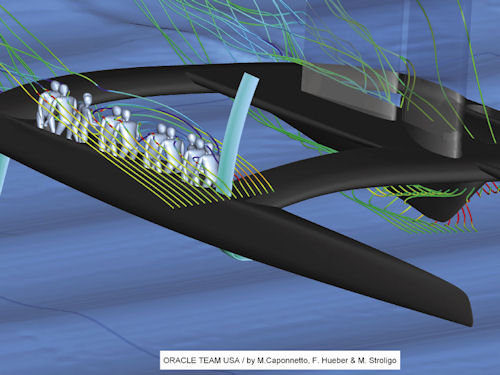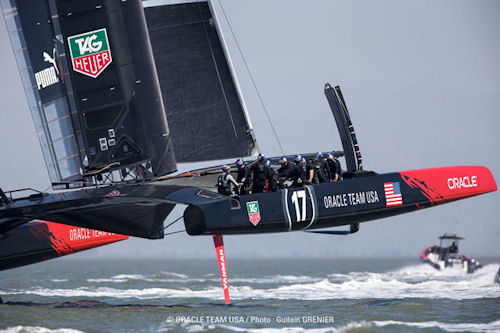Latest News
December 1, 2013
 CFD-simulated airflow across structure and crew. Analysis done with CD-adapco STAR CCM+ software. (Image courtesy Oracle Team USA and CD-adapco) |
Mario Caponnetto, Oracle Team USA’s design executive for wing sail design and head of CFD analyses, points out that, from the beginning, the 34th America’s Cup competitors worked with extreme parameters—the brand-new AC72 class rule defining a high-performance, 72-ft. catamaran running under a semi-rigid wing sail. From a performance optimization point of view, every part of a high-speed catamaran boat (below or above the water) is equally important. But the 131-ft.-tall wing sail was a particular challenge: “Although water is 800 times denser than air, there is a lot more yacht surface moving in the wind than in the sea, especially for a foiling AC72 catamaran,” Caponnetto explains.
Knowing that aerodynamic drag would be critical to operating speed (expected to reach more than 53mph), the team applied STAR-CCM+ from the beginning to evaluate and optimize hydrodynamic and aerodynamic performance. Caponnetto’s analysts used Reynolds-averaged Navier-Stokes (RANS) equations to obtain time-averaged behavior during turbulent flow; they also applied large eddy simulations (LES) to some detailed areas.
“Most of the simulations were pure CFD analysis, steady or unsteady, with multiple degrees of freedom and fluids, capturing the air/water interface and cavitation effects,” he says. “Sometimes we had to test each candidate geometry for hundreds of different combinations of speed and trim.”
The only way to avoid mistakes in comparing so many tiny differences among shapes was to maintain the consistency of the mesh and the physical model as much as possible. The STAR-CCM+ solution was to automate the simulation process.
During the previous America’s Cup, the team used structured meshes for most of the computations, Caponnetto explains. This time, they switched to automatically trimmed, polyhedral cells.
CFD on the Fly
Anyone watching the 2013 America’s Cup races saw the drama unfold as Oracle Team USA worked to come back at the 1-8 point in the event. Caponnetto describes three ways that CFD calculations were involved even then, supporting decisions for critical modifications to the boat’s structure and operation.
The first step involved reducing the safety margin when trimming the wing sail; simulations convinced the sailing crew to increase the load on the lowest flap, pushing the safety margin. Increased aerodynamic efficiency—plus reduced overall hydrodynamic drag—was the positive result.
 CFD-simulated airflow across structure and crew. Analysis done with CD-adapco STAR CCM+ software. (Image courtesy Oracle Team USA and CD-adapco) |
The second improvement produced a faster maneuver when making the upwind transition between low-speed (hull in the water) sailing to high-speed (hydrofoiling) mode. According to Caponnetto, the stern “wasn’t producing enough lift, so we decided to modify it with a device we have CFD-tested many times. A small fixed wedge glued below the transom greatly increased the local pressure and lift with only minor drag.”
Third, the design team worked with the cavitation module of STAR-CCM+ through the final race day, confident enough in the CFD simulation results to physically modify the rudder/elevator junction, reducing cavitation over these appendages and increasing the top speed for the first leg of each race.
Oracle Team USA also investigated fluid-structure interactions (FSI) on the appendages and the wing sail by using the STAR CCM+ built-in finite volume stress solver as well as performing co-simulation with Dassault Systèmes SIMULIA Abaqus finite element analysis software.
Caponnetto was in on the ground floor betting on CFD vs. physical experiments for boat design. “Now I can say for the first time all fluid dynamic design during America’s Cup has been carried out with the use of CFD only,” he says. “Some of the insights we obtained were unthinkable even 10 years ago, such as the modification of boat features during the last week of races. It is fascinating to think what will happen in the future.”
More Info
Subscribe to our FREE magazine, FREE email newsletters or both!
Latest News
About the Author
DE’s editors contribute news and new product announcements to Digital Engineering.
Press releases may be sent to them via [email protected].






